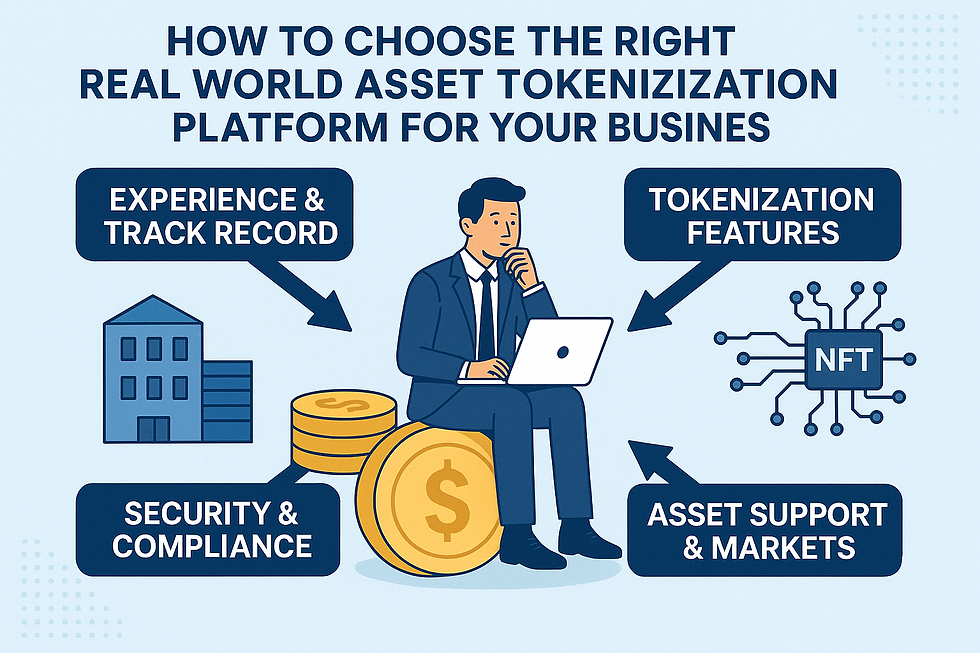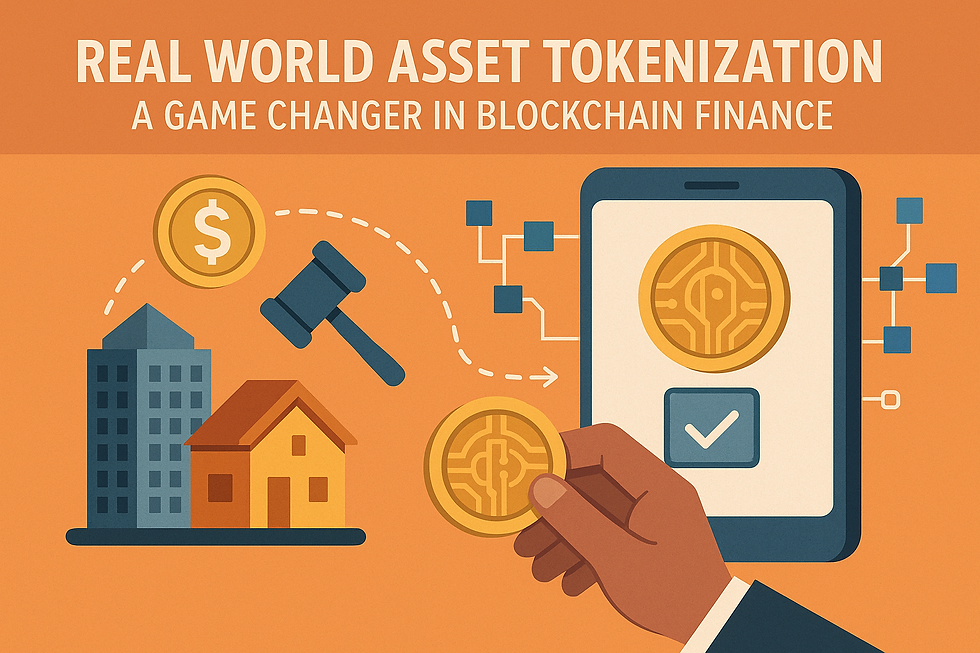How to Choose the Right Real World Asset Tokenization Platform for Your Business
- steveganger
- 1 minute ago
- 5 min read
Introduction: The Future of Assets Lies in Tokenization
The financial landscape is rapidly transforming, and Real World Asset Tokenization Platforms are at the center of it. Businesses across industries — from real estate to commodities — are now discovering how tokenization can bring liquidity, transparency, and global accessibility to traditionally illiquid assets.
But with so many tokenization providers claiming to be the “best,” how can you select the right one for your business? Let’s break it down step-by-step.
What is a Real World Asset Tokenization Platform?
A Real World Asset Tokenization Platform enables companies to convert physical or traditional financial assets into digital tokens using blockchain technology. These tokens represent ownership rights, shares, or claims over real-world assets such as real estate, gold, art, or corporate bonds.
Understanding Asset-Backed Tokens
Asset-backed tokens are digital representations of physical or financial assets. For example, one token could represent one square foot of property or one gram of gold. This innovation allows investors to buy fractional ownership rather than entire assets.
The Role of Blockchain in Tokenization
Blockchain acts as the infrastructure for recording ownership and transferring tokens. It ensures transparency, immutability, and security, preventing manipulation or double spending.
Why Businesses are Turning to Digital Asset Issuance
Businesses embrace digital asset issuance because it lowers entry barriers for investors, reduces operational inefficiencies, and increases liquidity. Tokenized models also attract a global investor base by removing geographical limitations.
Key Benefits of Using a Real World Asset Tokenization Platform
Enhanced Liquidity for Illiquid Assets
Tokenization converts traditionally illiquid assets like real estate or fine art into tradable tokens, opening secondary market opportunities.
Fractional Ownership and Global Access
Instead of needing millions to invest in property, anyone can buy tokens worth a few dollars. This democratizes investment and attracts a wider audience.
Improved Transparency and Security
All transactions and ownership records are stored on-chain, providing real-time verification and reducing fraud risk.
Core Features to Look for in a Tokenization Platform
When evaluating a Real World Asset Tokenization Platform, these core features matter the most:
Regulatory Compliance and KYC/AML Integration
The platform must comply with global securities laws and include built-in KYC/AML (Know Your Customer/Anti-Money Laundering) features to ensure legal safety.
Smart Contract Automation and Token Standards
Smart contracts handle token issuance, transfers, and dividends automatically. Ensure the platform supports popular standards like ERC-20, ERC-1400, or BEP-20.
Scalability and Blockchain Asset Infrastructure
A strong blockchain asset infrastructure ensures that your platform can handle large transaction volumes as your business scales.
Multi-Asset Support and Customization Options
Your platform should support diverse assets — from real estate to carbon credits — and allow you to customize token properties like dividend rights or voting power.
How to Evaluate Token Creation Capabilities
Supported Token Standards
Your Real World Asset Tokenization Platform should offer flexibility with standards like ERC-20 for fungible tokens or ERC-721 for unique assets such as collectibles.
Asset Type Compatibility
Whether tokenizing real estate, bonds, or commodities, the platform must handle each asset’s compliance and structure appropriately.
Secondary Market Integration
Liquidity depends on how easily tokens can be traded. A strong secondary market integration ensures ongoing token value and investor trust.
Security and Governance in Tokenization Platforms
Data Protection and Encryption Standards
Your platform must comply with high-level encryption protocols (like AES-256) and blockchain-level security to prevent breaches.
Role-Based Access and Audit Trails
Multi-user systems with defined access roles reduce risk and maintain traceability across all asset operations.
On-Chain Governance Mechanisms
Some platforms integrate governance tools that allow token holders to vote on changes — enhancing community engagement and transparency.
Choosing Between Public, Private, or Hybrid Blockchain Models
Pros and Cons of Public Blockchains
Public blockchains like Ethereum offer high transparency and decentralization but may suffer from higher gas fees.
Why Private or Consortium Models Fit Enterprises
Private models are ideal for enterprises seeking compliance control, privacy, and scalability.
Hybrid Systems for Flexible Control
Hybrid solutions combine transparency with privacy — public visibility with enterprise-grade confidentiality.
Integration with Existing Business Systems
API and SDK Compatibility
Look for platforms with easy API access to integrate tokenization into your company’s software ecosystem.
ERP and Financial Software Integration
Seamless integration with ERP or financial management systems simplifies accounting, compliance, and operations.
Cost Factors and ROI Considerations
Setup, Maintenance, and Transaction Costs
Different platforms have varying pricing models. Evaluate setup fees, transaction costs, and ongoing maintenance expenses.
Measuring Return on Tokenization Investments
ROI isn’t just financial — it’s about liquidity, reduced overhead, and faster investor onboarding.
Top Mistakes to Avoid When Choosing a Tokenization Platform
Ignoring Regulatory Frameworks
Tokenization is still subject to securities laws. Avoid platforms that overlook legal compliance.
Overlooking Security Protocols
Never compromise on security for cost savings — your asset value depends on it.
Choosing Style Over Functionality
A sleek dashboard is useless if the platform lacks key blockchain capabilities or compliance support.
Case Study: How Businesses are Leveraging Tokenization
Real Estate Tokenization Success Story
A Dubai-based property firm tokenized luxury apartments, allowing investors worldwide to own fractions of premium real estate. The result? Faster fundraising and 3x liquidity improvement.
Supply Chain Tokenization Use Case
A global logistics company tokenized shipment invoices, enabling faster trade finance access and improved transparency.
How to Get Started with a Real World Asset Tokenization Platform
Step 1: Define Your Tokenization Objectives
Clarify your goals — liquidity, fundraising, or investor reach. This helps you choose a platform that aligns with your strategy.
Step 2: Research and Compare Vendors
Shortlist vendors based on compliance, scalability, and token creation features. Request demos before committing.
Step 3: Pilot, Test, and Scale
Start small, test your token model, and scale once the system proves effective and compliant.
Conclusion: Tokenization as the Gateway to the Digital Economy
The right Real World Asset Tokenization Platform isn’t just a tool — it’s your business’s bridge to the digital economy. It transforms how you manage assets, raise capital, and engage with investors. By choosing a compliant, secure, and scalable platform, you can unlock new business models and financial opportunities that were once out of reach.
FAQs about Real World Asset Tokenization Platforms
1. What exactly is a Real World Asset Tokenization Platform?It’s a digital system that turns physical assets into blockchain-based tokens representing ownership or value rights.
2. How do asset-backed tokens differ from cryptocurrencies?Asset-backed tokens are tied to tangible or financial assets, while cryptocurrencies are purely digital with no physical backing.
3. Are tokenized assets legally recognized?Yes, in most jurisdictions, provided the platform complies with securities and financial regulations.
4. How secure are these tokenization platforms?They use blockchain encryption and smart contracts to ensure data integrity, transparency, and safety.
5. What industries benefit the most from tokenization?Real estate, supply chain, commodities, art, and finance industries gain the most from asset tokenization.




Comments